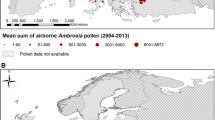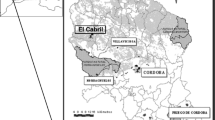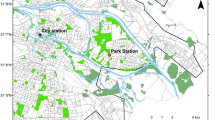Abstract
This study aims to find likely sources of Ambrosia pollen recorded during 2007 at five pollen-monitoring sites in central Europe: Novi Sad, Ruma, Negotin and Nis (Serbia) and Skopje (Macedonia). Ambrosia plants start flowering early in the morning and so Ambrosia pollen grains recorded during the day are likely to be from a local source. Conversely, Ambrosia pollen grains recorded at night or very early in the morning may have arrived via long-range transport. Ambrosia pollen counts were analysed in an attempt to find possible sources of the pollen and to identify Ambrosia pollen episodes suitable for further investigation using back-trajectory analysis. Diurnal variations and the magnitude of Ambrosia pollen counts during the 2007 Ambrosia pollen season showed that Novi Sad and Ruma (Pannonian Plain) and to a lesser degree Negotin (Balkans) were located near to sources of Ambrosia pollen. Mean bi-hourly Ambrosia pollen concentrations peaked during the middle of the day, and concentrations at these sites were notably higher than at Nis and Skopje. Three episodes were selected for further analysis using back-trajectory analysis. Back-trajectories showed that air masses brought Ambrosia pollen from the north to Nis and, on one occasion, to Skopje (Balkans) during the night and early morning after passing to the east of Novi Sad and Ruma during the previous day. The results of this study identified the southern part of the Pannonian Plain around Novi Sad and Ruma as being a potential source region for Ambrosia pollen recorded at Nis and Skopje in the Balkans.







Similar content being viewed by others
References
Apatini D, Replyuk E, Novak E, Paldy A (2008) Ragweed pollution in Hungary, 1992–2007. 4th European Symposium on Aerobiology, Turku, Finland
Bartková-Scevková J (2003) The influence of temperature, relative humidity and rainfall on the occurrence of pollen allergens (Betula, Poaceae, Ambrosia artemisiifolia) in the atmosphere of Bratislava (Slovakia). Int J Biometeorol 48:1–5. doi:10.1007/s00484-003-0166-2
Belmonte J, Vendrell M, Roure JM, Vidal J, Botey J, Cadahía A (2000) Levels of Ambrosia pollen in the atmospheric spectra of Catalan aerobiological stations. Aerobiologia 16(1):93–99. doi:10.1023/A:1007649427549
Bianchi DE, Schwemmin DJ, Wagner WH Jr (1959) Pollen release in the common ragweed (Ambrosia artemisiifolia). Bot Gaz 120(4):235–243. doi:10.1086/336030
Brandt J, Christensen JH, Frohn LM, Berkowicz R (2001a) Operational air pollution forecasts from regional scale to urban street scale. Part 1: system description. Phys Chem Earth Pt B 26(10):781–786. doi:10.1016/S1464-1895(01)00127-2
Brandt J, Christensen JH, Frohn LM, Berkowicz R (2001b) Operational air pollution forecasts from regional scale to urban street scale. Part 2: performance evaluation. Phys Chem Earth Pt B 26(10):825–830
Cecchi L, Morabito M, Domeneghetti MP, Crisci A, Onorari M, Orlandini S (2006) Long distance transport of ragweed pollen as a potential cause of allergy in central Italy. Ann Allergy Asthma Immunol 96(1):86–91
Comtois P (1998) Ragweed (Ambrosia sp.): the Phoenix of allergophytes. 6th International Congress on Aerobiology. Satellite Symposium Proceedings: Ragweed in Europe. ALK Abelló, Perugia, Italy
Dahl A, Strandhede S-O, Wihl J-A (1999) Ragweed - an allergy risk in Sweden? Aerobiologia 15(4):293–297. doi:10.1023/A:1007678107552
Faegri K, Iversen J (1992) Textbook of Pollen Analysis. John Wiley and Sons.
Filipovski Đ, Rizovski R, Ristevski R (1996) Karakteristiki na klimatsko-vegetacisko-počvenite zoni (regioni) vo Republika Makedonija. Skopje, MANU: 177.
Hirst JM (1952) An automatic volumetric spore trap. Ann Appl Biol 39(2):257–265. doi:10.1111/j.1744-7348.1952.tb00904.x
Jäger S (1998) Global aspects of ragweed in Europe. 6th International Congress on Aerobiology. Satellite Symposium Proceedings: Ragweed in Europe. ALK Abelló, Perugia, Italy.
Jäger S (2000) Ragweed (Ambrosia) sensitisation rates correlate with the amount of inhaled airborne pollen. A 14-year study in Vienna, Austria. Aerobiologia 16(1):149–153. doi:10.1023/A:1007603321556
Janjić V, Vrbničanin S, Stanković-Kalezić R, Radivojević L, Marisavljević D (2007) Poreklo i rasprostranjenost ambrozije. In: Janjić V, Vrbničanin S (eds) Ambrozija. Herbološko društvo, Srbije Beograd, pp 17–28
Jarai-Komlodi M, Juhasz M (1993) Ambrosia elatior (L.) in Hungary (1989–1990). Aerobiologia 9:75–78. doi:10.1007/BF02311373
Járai-Komlódi M (2000) Some details about ragweed airborne pollen in Hungary. Aerobiologia 16(2):291–294. doi:10.1023/A:1007660804839
Juhász M (1998) The history of ragweed in Europe. 6th International Congress on Aerobiology. Satellite Symposium Proceedings: Ragweed in Europe. ALK Abelló, Perugia, Italy.
Juhász M, Juhász I, Gallovich R, Radisic P, Ianovici N, Peternel R, Kofol-Seliger. (2004) Last year's ragweed pollen concentrations in the southern part of Carpathian Basin. Proceedings: 11th Symposium on Analytical and Environmental problems, Szeged, Hungary.
Laaidi K, Laaidi M (1999) Airborne pollen of Ambrosia in Burgundy (France) 1996–1997. Aerobiologia 15(1):65–69. doi:10.1023/A:1007547919559
Laaidi M, Thibaudon M, Besancenot J-P (2003) Two statistical approaches to forecasting the start and duration of the pollen season of Ambrosia in the area of Lyon (France). Int J Biometeorol 48(2):65–73. doi:10.1007/s00484-003-0182-2
Makovcová S, Zlinská J, Mikolás V, Salát D, Krio M (1998) Ragweed in Slovak Republic. 6th International Congress on Aerobiology. Satellite Symposium Proceedings: Ragweed in Europe, Perugia, Italy, ALK Abelló.
Makra L, Juhász M, Béczi R, Borsos E (2005) The history and impacts of airborne Ambrosia (Asteraceae) pollen in Hungary. Grana 44:57–64. doi:10.1080/00173130510010558
Manea D, Chirita R (2006) Ambrosia artemisiifolia L.: A new expansive weed in the Banat’s plain. J Cent Eur Agric 7(1):223
Milkovska S, Cvetanov V, Karadzinska-Bislimovska J, Matevski V, Janackov B Risteska-Kic, Minov, J, Ezova, N, Yankova R (2007) Aeropallinological and allergenic significance of Ambrosia and Artemisia in the Republic of Macedonia. 3rd Congress of ecologists of the Republic of Macedonia with international participation Macedonian Ecological Society, Struga, Republic of Macedonia
Mosyakin SL, Yavorska OG (2002) The nonnative flora of the Kyiv (Kiev) Urban Area, Ukraine: a checklist and brief analysis. Urban Habitats 1(1):45–65
Ogden EC, Hayes JV, Raynor GS (1969) Diurnal patterns of pollen emission in Ambrosia, Phleum, Zea and Ricinus. Am J Bot 56(1):16–21. doi:10.2307/2440389
Pérez-Landa G, Ciais P, Gangoiti G, Palau JL, Carrara A, Gioli B, Miglietta F, Schumacher M, Millán MM, Sanz MJ (2007a) Mesoscale circulations over complex terrain in the Valencia coastal region, Spain - Part 2: Modeling CO2 transport using idealized surface fluxes. Chem Phys 7:1851–1868
Pérez-Landa G, Ciais P, Sanz MJ, Gioli B, Miglietta F, Palau JL, Gangoiti G, Millán MM (2007b) Mesoscale circulations over complex terrain in the Valencia coastal region, Spain – Part 1: Simulation of diurnal circulation regimes. Atmos Chem Phys 7:1835–1849
Peternel R, Culig J, Srnec L, Mitic B, Vukusic I, Hrga I (2005) Variation in ragweed (Ambrosia artemisiifolia L.) pollen concentration in Central Croatia. Ann Agric Environ Med 12(1):11–16
Peternel R, Culig J, Hrga I, Hercog P (2006) Airborne ragweed (Ambrosia artemisiifolia L.) pollen concentrations in Croatia, 2002–2004. Aerobiologia 22:161–168. doi:10.1007/s10453-006-9028-9
Rybnícek O, Jager S (2001) Ambrosia (Ragweed) in Europe. Allergy Clin Immunol 13(2):60–66. doi:10.1027/0838-1925.13.2.60
Rybnícek O, Novotná B, Rybníckova E, Rybnícek K (2000) Ragweed in the Czech Republic. Aerobiologia 16(2):287–290. doi:10.1023/A:1007611715820
Saar M, Gudžinskas Z, Plompuu T, Linno E, Minkiene Z, Motiekaityte V (2000) Ragweed plants and airborne pollen in the Baltic States. Aerobiologia 16(1):101–106. doi:10.1023/A:1007670229308
Seliger AK (1998) Ragweed in Slovenia. Satellite Symposium Proceedings: Ragweed in Europe. 6th International Congress on Aerobiology. ALK Abelló, Perugia, Italy.
Šikoparija B, Radišić P, Pejak T, Šimić S (2006) Airborne grass and ragweed pollen in the southern Panonnian Valley - consideration of rural and urban environment. Ann Agric Environ Med 13:263–266
Skjøth AC, Hertel O, Ellermann T (2002) Use of the ACDEP trajectory model in the Danish nation-wide Background Monitoring Programme. Phys Chem Earth Pt B 27(35):1469–1477. doi:10.1016/S1474-7065(02)00149-3
Skjøth CA, Smith M, Brandt J, Emberlin J (2008a) Are the birch trees in Southern England a source of Betula pollen for North London? Int J Biometeorol (October):2008 (Accepted for publication).
Skjøth CA, Sommer J, Brandt J, Hvidberg M, Geels C, Hansen KM, Hertel O, Frohn LM, Christensen JH (2008b) Copenhagen - significant source to birch (Betula) pollen? Int J Biometeorol 52(6):453–462. doi:10.1007/s00484-007-0139-y
Skjøth CA, Sommer J, Stach A, Smith M, Brandt J (2007) The long range transport of birch (Betula) pollen from Poland and Germany causes significant pre-season concentrations in Denmark. Clin Exp Allergy 37:1204–1212. doi:10.1111/j.1365-2222.2007.02771.x
Smith M, Emberlin J, Kress A (2005) Examining high magnitude grass pollen episodes at Worcester, United Kingdom, using back-trajectory analysis. Aerobiologia 21(2):85–94. doi:10.1007/s10453-005-4178-8
Smith M, Skjøth CA, Myszkowska DAU, Puc M, Stach A, Balwierz Z, Chlopek K, Piotrowska K, Kasprzyk I, Brandt J (2008) Long-range transport of Ambrosia pollen to Poland. Agric For Meteorol 148:1402–1411. doi:10.1016/j.agrformet.2008.04.005
Stach A, Smith M, Skjøth CA, Brandt J (2007) Examining Ambrosia pollen episodes at Poznan (Poland) using back-trajectory analysis. Int J Biometeorol 51:275–286. doi:10.1007/s00484-006-0068-1
Stepalska D, Szczepanek K, Myszkowska D (2002) Variation in Ambrosia pollen concentration in Southern and Central Poland in 1982–1999. Aerobiologia 18(1):13–22. doi:10.1023/A:1014926216282
Stevanović V, Stevanović B (1995) Osnovni klimatski, geoloski i pedoloski činioci biodiverziteta kopnenih ekosistema Jugoslavije. In: Stevanović V, Vasić V (eds) Biodiverzitet sa pregledom vrsta od medjunarodnog značaja. Biološki fakultet i Ekolibri, Beograd, pp 75–95
Taramaracaz P, Lambelet C, Clot B, Keimer C, Hauser C (2005) Ragweed (Ambrosia) progression and its health risks: will Switzerland resist this invasion? Swiss Med Wkly 135:538–548
Vitányi B, Makra L, Juhász M, Borsos E, Béczi R, Szentpéteri M (2003) Ragweed pollen concentration in the function of meteorological elements in the south-eastern part of Hungary. Acta Climatol Chorologica 36–37:121–130
White JF, Bernstein DI (2003) Key pollen allergens in North America. Ann Allergy Asthma Immunol 91(5):425–435
Ziska LH, George K, Frenz DA (2007) Establishment and persistence of common ragweed (Ambrosia artemisiifolia L.) in disturbed soil as a function of an urban-rural macro-environment. Glob Change Biol 13:266–274. doi:10.1111/j.1365-2486.2006.01264.x
Acknowledgements
This work was partly funded by the Copenhagen Global Change Initiative (www.cogci.dk), by the SCOPES JRP no. IB73A0-11034 and by the Ministry of Science R. Serbia project no. 143037. The authors would like to thank the National Centres for Environmental Prediction (NCEP) for providing input data to the Eta model and for providing verifying meteorological observations exchanged under the World Meteorological Organization (WMO) World Weather Watch Programme. The results presented here address two of the main scientific challenges described in COST Action ES0603 (EUPOL) (http://www.cost.esf.org/index.php?id=1080), specifically Work Package 1 (pollen production and release) and Work Package 2 (pollen atmospheric distribution and interaction).
Author information
Authors and Affiliations
Corresponding author
Rights and permissions
About this article
Cite this article
Šikoparija, B., Smith, M., Skjøth, C.A. et al. The Pannonian plain as a source of Ambrosia pollen in the Balkans. Int J Biometeorol 53, 263–272 (2009). https://doi.org/10.1007/s00484-009-0212-9
Received:
Revised:
Accepted:
Published:
Issue Date:
DOI: https://doi.org/10.1007/s00484-009-0212-9




